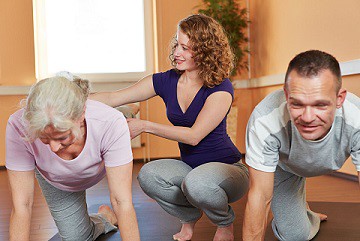
By Dana Auriemma
Hour-after-hour and day-after-day you teach. You give many of the same cues and corrections to clients again and again until you sometimes sound like a broken record. You may feel a little stale and notice your energy and passion start to slide.
It’s no secret among instructors that becoming bored or stale in your teaching is a hazard of the job. To combat this, instructors must find ways to freshen-up their teaching and dedicate extra time and effort to do so. But when time is limited and you’re on the verge of feeling burnt out, where are the best places to look for inspiration and new ideas?
Here is a list of 10 fun things you can do to freshen up your teaching. It includes a mix of different options for you to choose what fits best depending on the time or situation. Look to this whenever you feel your teaching has become a little monotonous. And keep in mind that new ideas can come from almost anywhere, even the most unexpected places. So look around at your surroundings and experiences outside the studio and find a few more things of your own to add to the list!
1. Go out and get adventurous.
Get out of the studio environment and try a sport or activity that involves full-body work. Try rock climbing walls, kayaking, tennis, hiking or even something a little wild like acrobatics (think trampolines, aerial silks or flying trapeze)! The objective is to use and challenge your body in a functional, athletic and adventurous way. You’ll feel your muscles working together in unique ways and that will give you new ideas for how to train them in the studio.
2. Try a really different type of fitness program.
It’s easy to get settled into only practicing our own type of exercise, but that’s a first-class ticket to boredom-town. So get out and try something new and aim for a program that is really different from what you typically teach. It will make you feel like a student again (hello compassion!) and you’ll get to admire different teaching techniques that may be more common in other exercise programs. But while you’re stretching or sweating-it-out in your new class, don’t forget to check out the other students and observe what they are enjoying most about their exercises or workout experience. Then use that as inspiration for your own teaching.
 3. Watch online (with a twist).
3. Watch online (with a twist).
There are oodles and oodles of online fitness classes now available from a variety of professional and accredited sources. These classes are affordable and offer tons of options when it comes to themes, props or special populations. Here’s the twist through – watch specialty classes, even if they don’t fit the clients you teach. For example: watch classes for seniors, dancers, men, prenatal or issues like scoliosis, back pain or osteoporosis, even if you don’t have these clients. It will give you some great new ideas on how to do traditional exercises differently that you’ll use more broadly than you might think.
4. A is for anatomy.
Crack open a book, manual or online tutorial and revisit your anatomy lessons. Pick an area of the body you’d like to get to know better and study-up! When you spend time learning more about the body it goes without saying it will improve your teaching. And more specifically, it will give you some fresh ideas and a new approach to the same old exercises you’ve been teaching for years. You’ll be throwing out new cues and corrections and your students will be leaving class excited about the new lessons they learned.
5. Buy a new prop or revisit an old one.
There is a sea of fitness props out there all waiting to be used. Rollers, rings, bands and balls are most common but there are so many more to choose from (i.e. wobble boards, rotating discs, weight balls, stretching straps) - or pull out an old prop you haven’t used in a while and it will feel like new! Experiment with adding the prop to your traditional or most commonly taught exercises. Try integrating it in different ways and see how it impacts each exercise (some will be value-add, others won’t). If you’re stuck on ideas, you can easily find online videos (see #3) to help.
6. Set-up an exercise exchange program.
Two heads are better than one! So schedule a team workout with fellow instructors. Plan a round-robin class where each person teaches for 15-20 minutes. But the real challenge is that each person has to pull out his or her most interesting and creative exercise variations. No traditional choreography is allowed. For the duration of the class, just let go of any rules or constraints that you might typically adhere to and design your own personal variations. Even if you don’t take your creative moves back to your teaching practice (perhaps you follow a classical or traditional repertoire) the experience of trying them out will give you a new perspective and fresh approach to whatever exercise you teach.
7. Watch a dance performance.
There is almost nothing that uses the body so completely as professional dance. When you watch dancers, you can see muscle engagement and range of motion that shows you how fully the body is capable of moving! So grab a ticket to a local dance performance or even watch one on TV or YouTube. As you watch the dancers, think about what exercises can train the movements you are seeing. Try some inspired variations or play with a new class flow. Dancing is also great inspiration for the verbal cadence and rhythm of teaching- how you speak, cue and flow the exercises and transitions.
8. Research other fitness programs.
There are new fitness methods being developed by professionals all over the world! Often with a background in Pilates, yoga, dance or sports, these fitness innovators are creating new programs that fuse together different principles and choreography or create new ones. While not all of the programs may follow the standards that you uphold, most still offer something interesting to learn from and will provide some inspiration for your own teaching.
9. Schedule playtime.
It’s difficult to find workout time much less playtime but the latter is oh-so-fun and keeps your teaching fresh. Keep it simple and just schedule one session a week - by yourself or perhaps with another instructor. Don’t plan to workout. Plan to explore and experiment. Revisit exercises you are really rusty with. Pull out props, test out modifications, variations or progressions you can give clients who might be struggling with an exercise. You’ll easily walk away with a few new ideas to put into your teaching for the next week.
10. Observe other teachers.
It’s inspiring to watch other talented teachers in action! And it never fails that you will observe something new and interesting about how they teach. How do they cue, correct and transition? What exercises do they pull out, how do they structure their sessions and how do they handle challenging client issues? Also observe the clients. That is equally interesting and telling. Ask yourself what do the clients seem to enjoy most or least about their sessions and how might it influence your own teaching.
Use this list, make your own or try a combination of both. Then set a reminder on your calendar or schedule some time on a regular basis to get inspired! If you do, you’ll be sure to enjoy fuller classes, happier clients and fun work days that fly by all-to-fast!

About Dana Auriemma
Dana started her professional career in marketing and sales working for Fortune 500 companies, but later moved out of the corporate world to pursue her passion in fitness. She opened, grew and sold a thriving Pilates studio and is now dedicated to helping other studio owners and teachers master the marketing and business skills needed to reach their full potential! Dana publishes free training articles plus online and live business courses coming soon. Visit her at danaauriemma.com or facebook.com/danaauriemma.training.